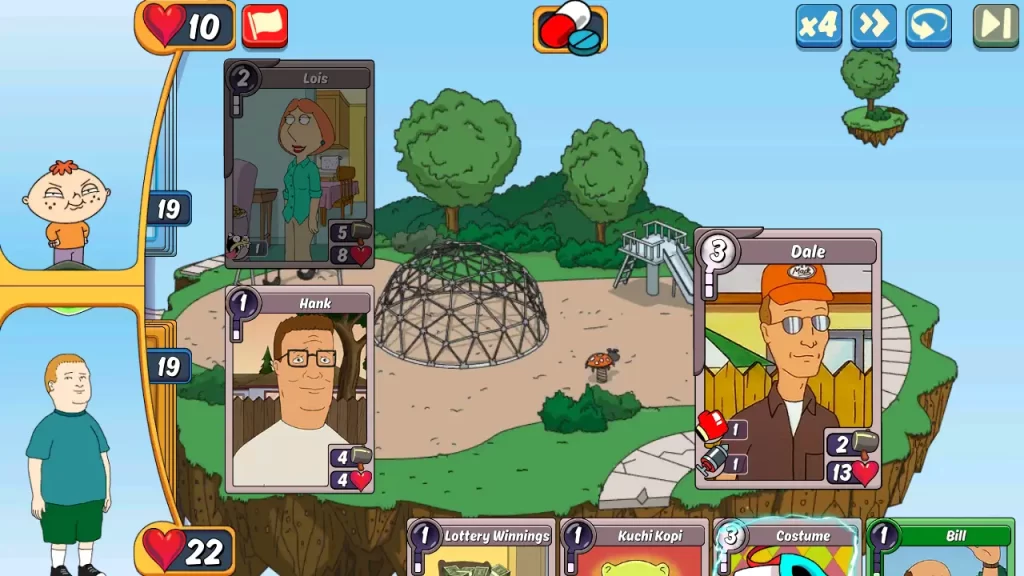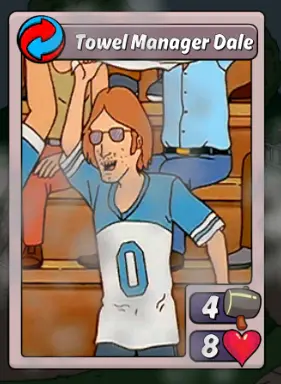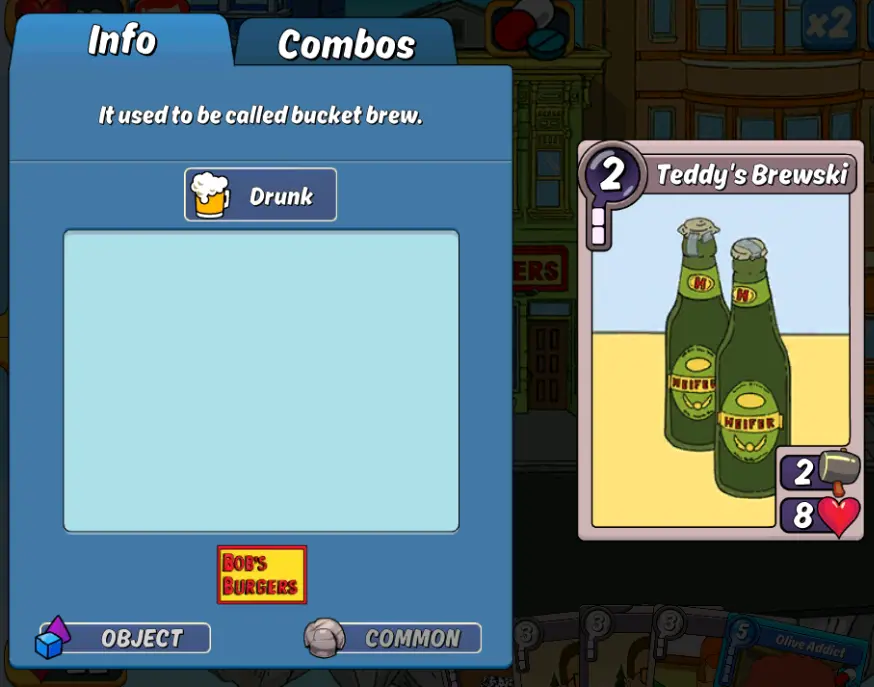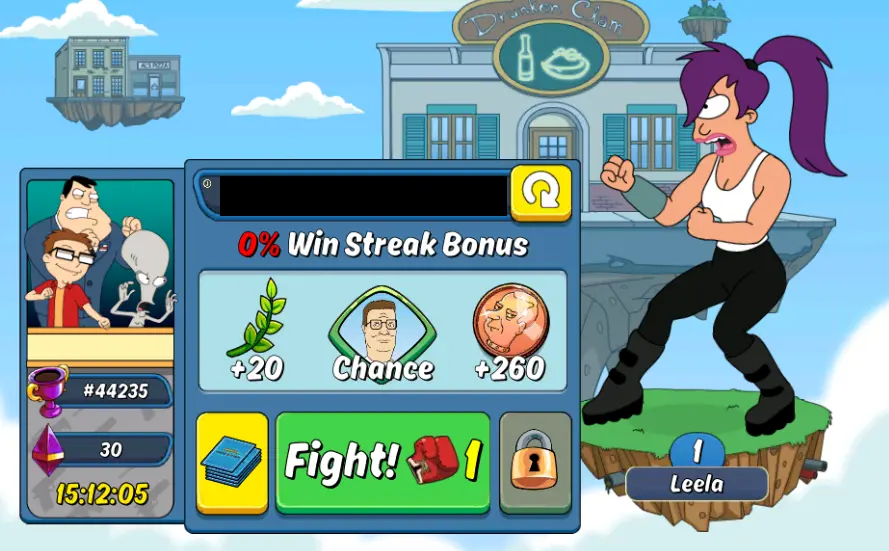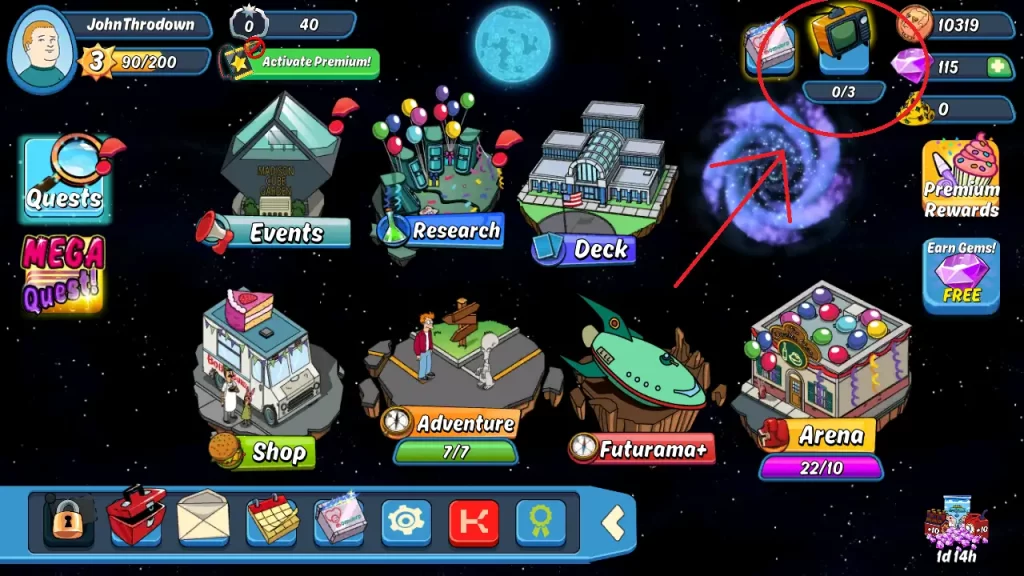When I was a kid growing up in the 90s, crossovers were the stuff of legend. Any time universes crashed together – such as the “Bravo-Dooby-Doo” episode of Johnny Bravo – I was always blown away. And with this tease of the possibility of multiverses came a slew of “what-if” scenarios that developed over the past three decades, not just in animation, but in games, comics, movies – you name it, it probably exists.
But today? We’re going with card games.
Animation Throwdown: The Quest for Cards is a game where you summon your favorite (or unfavorite, I’m not judging) characters from multiple animated universes to beat the snot out of your enemy in a card game. It’s simple, but engaging, easy to learn, but difficult to master. Oh, and it’s great fun, too.
Animation Throwdown: The Quest for Cards is available on both the Google Play Store and the App Store. Animation Throwdown has been around since 2016, so you can also play it in its first incarnation on Kongregate’s website (hello, Rebuild!) or via Steam. For brevity’s sake, I’ll refer to the game as just Animation Throwdown for the rest of this guide.
While the game has been around for quite a while now, it’s still very popular thanks to its ties with pop culture as well as its easy-to-learn mechanics. If you’re a potential new player who’s apprehensive about making the leap or if you’re trying to make sense of Animation Throwdown so that you can build a coherent deck and formulate a sound strategy, look no further. This guide is for you!
In this beginner’s guide to Animation Throwdown, we’ll be going over:
- The game’s basic rules, because the game admittedly doesn’t do a very good job of outlining how to play the game aside from a quick “touch the cow, do it NOW”-style tutorial. We’ll be talking about game objectives, game flow, card basics, combat, and abilities here.
- The basics of strengthening your cards: The importance of Giggitywatts, rarity, and why you should budget your watts, as well as research, fusion, and card tiers.
- Sourcing your resources, because you need a steady flow of cards, gems, and more to ensure success in the higher ranks of Animation Throwdown.
Game Basics
While Animation Throwdown has a ton of personality, it could do a better job of explaining the game rather than throwing you into tutorial matches that all seem to show the same thing. Hence, this section is dedicated to the game’s basics – game flow, rules, mechanics, and more.
Quick Tips:
- Two players alternate between playing cards to reduce their opponent’s health to 0.
- Playing cards doesn’t cost anything but you can only play one card a turn.
- Note that there is no live PvP in Animation Throwdown and the human player always gets the first move.
- Each card deals damage equal to its attack. Cards with 0 health are destroyed and removed from the field.
- Cards cannot attack the turn they are placed on the board.
- Cards are placed in a lane. There doesn’t seem to be a limit to the number of lanes. During combat, cards will always fight the opponent’s card on the same lane. If there is no defending card, they’ll attack the player directly. Note that there is no counterattack damage.
- Lanes must be filled in ascending order; you can’t choose to play a card in lane 2 if you don’t have a card in lane 1. If you have any gaps from destroyed cards, your cards will instead be placed in the nearest empty lane.
- Any spillover damage from destroying a card is dealt to its owner, so you can’t infinitely defend yourself without counterattacking.
- Combos are a fusion of two cards played on top of each other. Combo cards are much stronger than their base parts.
- To combo, play a card over another card on the board. While holding a card (via long tap), any cards it can combo with will glow with a blue border. If a card can combo but requires research, it will have a beaker instead.
- You cannot combo cards in your hand. You can only combo on the board itself by playing an object on a character or vice-versa.
- The stronger the combo parts, the stronger the combo card.
- Cards also have powerful abilities to help them out. A card’s abilities appear opposite its attack and toughness stats.
- You can tap on a card to get a detailed readout of its abilities.
- I’ve also included a quick reference table of some of the most common abilities you’ll see in Animation Throwdown.
- Cards can have traits that don’t do anything on their own but allow those cards to be targets for certain abilities or battleground effects.
- Decks can consist of 25-35 cards.
- I suggest playing with just 25 cards to make your plays more consistent.
- Ensure that your deck has a good balance of offensive and defensive cards. As the first player in a match, playing a high-attack card (and possibly comboing it next turn) will allow you to seize immediate control of the playing field.
Game Objectives
The objective of a match of Animation Throwdown is to reduce your opponent’s health to 0.
To do this, you need to play cards on various lanes to attack them. These cards are comprised of characters from multiple animated universes – Family Guy, Archer, American Dad, Futurama, King of the Hill, and Bob’s Burgers – and serve as your frontline meat shields fighters. Character cards can further be upgraded and augmented with various items, allowing them to combo into more powerful versions of themselves.
Game Flow
The game flow of Animation Throwdown goes as such:
Note that, unlike other card games, Animation Throwdown does not have a resource system. You read that right – you can play your overpowered cards on turn one. The catch here is that players can only play one card per turn.
Confusing? If you put it into words, sure. But as you play the game, you’ll become more familiar with its flow, and you’ll Rarely (if ever) need to refer to this flow list.
One more thing – there is no live PvP in Animation Throwdown. All arena matches are played by an AI using that player’s deck. This means that the human player will always go first.
Combat and Lanes
What’s a card game without combat? Battles in Animation Throwdown are determined by comparing two stats: its attack power and its health.
In the sample card above, Bill has 5 attack (hammers) and 7 health (hearts). This means that Bill deals 5 points of damage when attacking and can sustain 7 damage before being removed from the board.
As mentioned earlier, the turn player’s cards attack automatically after their player has put a card on the board, and only if they’ve already been on the board for at least one turn. That means that cards cannot attack on the turn they’ve been played – but they can defend.
When combat starts, the turn player’s cards will attack their lane opponents (note that there is no counterattack damage); if they have no lane opponent, they’ll attack your opponent directly!
Wait, did I say “lanes”?
Lanes are how the game determines combat resolution. Each player has an unlimited amount of lanes, and they’re indicated by the red lines in the image above. This means that cards effectively have only two targets – their lane opponent or the enemy player. Note that in the image, my Bill is attacking an opponent’s card because they’re in the same lane…but my two Hanks, who have yet to attack, have no lane opponent. That means my opponent is going to take 10 direct damage, winning me the match!
Because cards are removed from the board when they’re destroyed, the question is this: what happens when lanes break due to cards being destroyed?
Lanes won’t regroup to fill the gap. It’s up to the turn player to keep playing cards – or dangerously ignore the now-empty lane. Note that you will always play cards in ascending lanes. Your first card always goes to lane 1, the second to lane 2, and so on. The only exception to this is when there’s a lane gap; in this case, the next card you play will fill the closest gap possible. For example, if you have cards in lanes 1, 3, and 5, your next card will go to lane 2 to block the gap. Combine this with the rule that cards can’t attack the turn they’re placed and you have a quick and easy way to win a game!
That’s not all, though. While it’s always preferable to have cards blocking dangerous lanes, you can’t wall off an opponent forever. Any leftover damage is dealt to the player. For example, if I have a 1 health card and my opponent attacks it with a 12 attack card, I’ll still take 11 damage.
Combos
“So”, you might say, “the objective of the game is to play as many high-value cards as possible to dominate each lane?” That’s technically correct, but we have yet to discuss combos.
Combos are akin to other card games’ power-up mechanics: evolution, overlaying, you name it. In Animation Throwdown, a combo is a fusion of two cards (most often a character and an object) which results in a much more powerful card. To combo, all you need to do is play a card on top of another one. When holding a card, any possible card combos will glow.
While most character cards can be combo’d with most objects, sometimes you’ll get a beaker icon instead. This means that that particular combo must first be researched. We’ll talk about research later on, but it’s a good rule of thumb to always be researching something – especially any combos involving cards that see frequent play.
There are a few more things you should know about combos:
Card Abilities
Now that we know how to play caveman Animation Throwdown – that is to say, we know how to beat each other over the head with the highest attack cards and combos – it’s time to get into the more technical side of things. In Animation Throwdown, this comes in the form of card abilities. A card’s abilities appear as icons to its left side, opposite its attack and health values.
There are two types of abilities, namely active and passive. Active abilities are triggered on a card’s turn before it attacks. This also means that cards that cannot attack (that is to say that card has just been played from the hand) do not trigger their active abilities on the same turn.
Passive abilities, on the other hand, are always in play. These abilities are always online even if a card has just been played. Passive abilities tend toward the defensive such as abilities that flat-out reduce damage taken.
There are a *lot* of abilities in Animation Throwdown. As you keep playing, you’ll eventually become familiar with these abilities and can tell them apart with a glance. But if you’re completely new, or haven’t memorized abilities yet, you can always tap on a card to get a readout of its abilities.
Here’s a quick list of some of the more common abilities and what they do. Note that all abilities have a value appended to them, which I’ll label as “X”.
- Boost X: Passive. Card gains X attack when you play a combo.
- Cheer X: Active. A random ally that hasn’t attacked yet gains X attack for one turn. Also has a Cheer All version, which gives X attack to all allies that haven’t attacked yet for one turn.
- Crazed X: Passive. Gain X attack after attacking.
- Cripple X: Active. Reduce the attack of a random enemy card by X for the next turn. Also has a Cripple All version, which reduces the attack of all enemy cards by X until the next turn.
- Heal X: Active. This card heals a random ally for X health. Also has a Heal All version, which heals all allies for X health.
- Jab X: Passive. Pierces X points of damage resistance for cards that have an ability that reduce incoming damage.
- Leech X: Passive. When this card attacks, heal it for X.
- Payback X: Passive. If this card survives combat, deal X damage to its attacker.
- Punch X: Active. This card does X damage to a random target.
- Recover X: Passive. When its owner plays a combo, this card gains X max (and current) health.
- Shield X: Active. Gives another card a shield that blocks X damage.
- Sturdy X: Passive. Blocks X damage when attacked.
Card Traits
Each card can also have one or several traits.
By themselves, traits don’t do anything. However, some cards’ abilities only target cards with traits, and BGEs (battleground effects), which we’ll discuss in the next section, heavily favor specific traits and encourage players to build around them.
Deck Size and Some Tips
Lastly, let’s discuss your deck and its size, as well as some tips for deckbuilding in Animation Throwdown.
Decks must be made of 25-35 cards. Because there are no costs attached to playing cards, it’s a good idea to fill your deck with the strongest cards you have. I also advise running the bare minimum of 25 cards; while there are no searchers in Animation Throwdown, a smaller deck size makes your plays that much more consistent. Not to mention that it’ll also save you research costs as a 25-card deck has much fewer combinations (though it’s still admittedly a lot) than a 35-card deck.
While we’re on the topic of deck building, ensure that your deck has a good combination of offensive and defensive options. Since you, as the human player, get to act first, playing a high-attack card on your first turn limits the AI’s plays; if you can immediately destroy the card they place on their first turn, you’ll have seized control of the playing field from the get-go.
On the other hand, you may lose lanes if your cards don’t have enough health to stave off attacks. Remember that you don’t have to win in every lane – you just need to chip out as much damage as you can from your opponent’s empty lanes. Cards with low attack and high health are great at stalling for game, but only play these defensive cards if you already have offensive control of a lane.
Strengthening Your Cards
As I’m fond of saying, strategy by itself is rarely enough. While a good deck in Animation Throwdown can scrape out wins with tricky combos and powerful abilities, you will still need the brute force necessary to execute your plans. Here’s how to ensure that your cards are the best they can be – this way, you don’t get beaten by just bigger numbers!
Quick Tips:
- Cards can be upgraded by spending Giggitywatts. The higher a card’s rarity, the more Giggitywatts it costs to upgrade.
- Cards have power levels that determine how many times they can be upgraded. Once a card’s power level is full, it must be fused with a copy of itself at the same power and fusion level to gain a fusion level. Fused cards are much, much more powerful than their base forms.
- Note that upgrades apply to individual copies of cards. Just because you upgraded one Hank to tier 2 doesn’t mean that all your Hanks will be as strong!
- It’s entirely up to you if you would rather have a few high fusion level cards or more low-level but consistent cards. Play on and discover what play style suits you best.
- Upgrading is expensive. Don’t upgrade your Commons and Rares if you can help it.
- Rarity and color in ascending order: gray (Common), Rare (green), epic (blue), legendary (purple), mythic (gold).
- The Rarer a card, the more power levels it can get.
- As you gain levels, you’ll eventually gain the ability to recycle cards for Giggitywatts. Use this to destroy cards you don’t need and recycle trash pulls into something useful.
- Always be researching something that you’ll use. There’s not much point in putting a card in your deck unless it has abilities or can combo, so take your time and do your research. Research is free, too!
- Always play Arena when you can. This not only nets you resources but more importantly hero tokens which can be used to unlock new heroes and improve existing ones.
- Leverage the current Battleground Effect (BGE) as this can massively boost the power of cards with certain traits.
Card Upgrades
Yes, your cards are nice. But they can be much stronger.
By infusing a card with Giggitywatts, you can not only boost its stats but even give it new abilities that allow it to take on new and different roles in your deck.
To upgrade a card, tap on it anywhere in your inventory (deck, archive, or so on) then select upgrade. This will consume Giggitywatts and give you a stronger copy of that card. Note that card upgrades are individual – just because you upgraded one Hank to power level 4 doesn’t mean all your Hank cards become power level 4!
Power levels refer to the pips to the upper left of a card. Depending on a card’s rarity, it may have a different number of pips, with Rarer cards tending to have more. Each upgrade you perform fills up one pip. Once all of a card’s upgrade pips are full, you’ll need to fuse it with an identical card – that is to say, they have the same power level and fusion level – to increase that card’s fusion level by one.
While fusing cards is a long and tedious process, the results are well worth it as fused cards, especially fusion level 2 cards, are leagues ahead of their base forms. If you find a favorite card and are lucky enough to pull duplicates of it, go ahead and get fusing!
This system raises the question: Should you always fuse cards? Fusing cards means that you’re giving up consistency for strength; in the image above, I have 4 Power Level 3/Fusion Level 0 Dale cards in my deck. If I wanted to, I could fuse them to get 2 Fusion Level 1 Dales, though that means I’ll be losing 2 Dales.
There’s no easy answer to this question, and it’s all up to you. As for myself, I tend to keep multiple low-fusion level copies of cards in my deck that have near-universal combo access. This makes my plays more consistent, though it does leave me susceptible to high attack beatdowns. The choice is entirely yours; keep playing and discover your own play style!
Budgeting
The catch to all this? Giggitywatts are a tough resource to farm – so much so that I strongly suggest not upgrading your Commons and Rares unless you absolutely must. Focus on your high-rarity cards as those will give you better returns on your spent Giggitywatts.
For reference, card rarities are as follows:
- Normal (gray)
- Rare (green)
- Epic (blue)
- Legendary (purple)
- Mythic (gold)
Later on, you’ll gain the ability to scrap cards into Giggitywatts. As you progress to the mid and late game, this will become your main source of Giggitywatts. Luckily, new players have a ton of quests and missions that hand out Giggitywatts, so don’t scrap just yet – you may regret it!
One more thing – the Rarer a card, the more power levels it can have. Thus, Rare cards are always superior to Common cards due to their larger potential for growth.
Research
Research is one of the most important things you need to do in Animation Throwdown.
We touched lightly on the topic of research in the “Game Basics” section. Some combos are locked behind research (as indicated by a beaker when you attempt to fuse). By researching those two cards – which involves locking them together in a chamber for 8 hours – you’ll unlock that combo, giving you access to more plays!
Because research is free – yes, you read that right – there’s no reason you shouldn’t always be researching something. However, because of its long timer, ensure that you’re always researching something relevantto your deck. There’s no point waiting 8 hours to unlock a combo that you’re never going to use anyway. Instead, focus on the cards you frequently use; if there are any potential combos between them that you haven’t yet unlocked, go for those first.
Do note that you’ll occasionally need to watch an ad to get research started and that there are speed-ups that reduce the research time of one chamber by a certain amount.
The Arena and Hero Tokens
Finally, let’s talk about strengthening your hero. Yes, they can be powered up too!
To upgrade your heroes, you’ll need to fight in the Arena. This will pit you against other players’ decks, though as I mentioned earlier, there is no live PvP – you’ll be fighting an AI using their deck.
Victory in the arena nets you a healthy amount of coins, and thanks to the streak bonus, you’ll get many more coins than you would out of campaign mode. Assuming you keep winning, of course. But more importantly, you can randomly get hero tokens when you win!
Hero tokens aren’t just for unlocking new heroes. If you get duplicate tokens of a hero you already have, you can spend those tokens to level them up, which not only boosts their health but even gives them passive abilities of their own.
Your arena energy is separate from your adventure energy, so be sure to empty your reserves whenever you can.
Battleground Effects
A Battleground Effect, or BGE, is an immensely powerful passive buff that affects cards with certain traits.
The buffs that a BGE provides are indescribably powerful, so much so that it’s always worth building a deck just to take advantage of the current BGE. You can’t escape BGEs either, as they take effect no matter what game mode you’re playing – be it adventure, arena, or event matches, the BGE will be there. BGEs run for three weeks at a time, and on the last week of a BGE, the devs will reveal the next one.
To check the current BGE, you can tap on the “Events” panel on the main screen; alternatively, you can tap the BGE icon at the top of the screen during a battle.
Sourcing Materials
Lastly, let’s talk about where to get the many resources you’ll need to get ahead in Animation Throwdown. While you probably know by now that you can fight just about anyone to get cards, there are a ton of hidden treasures that you’ll need to sniff around for. That, or consult this rundown.
Quick Tips:
- Always activate your ad boost before a play session.
- Join a guild as soon as you can to get a passive boost to your arena coin gain.
- Participate in events. You get rewards based on what tier you place in when the event ends, so yes, you do get points for trying.
- When an event ends, you get rewards based on how well you placed.
- You also get Challenge Coins just for fighting in events, which can be traded in for random hero tokens or a booster with a guaranteed Epic.
- Each victory in a campaign stage nets you one pip for that character. Get three pips and you’ll get a special prize along with your victory rewards. You can also see what special prizes a stage will hand out before selecting it.
- Note that the more you beat a character, the stronger they become and the more energy it costs to challenge them again.
- Always open your ad crates as they contain not only a good amount of coins but also speed boosters, and extra energy. Note that you can only have 5 unopened ad crates at once.
- Daily quests give you a lot of resources; more importantly, they serve as a small, renewable source of gems.
- The Megaquest is essentially a battle pass. There are both free and paid rewards.
The Ad Boost
Ads should come as no surprise. The devs gotta make money after all. But what may not be immediately obvious to a new player is that you can trigger a chain of ads to get a lingering income buff!
To trigger this bonus, you’ll need to specifically tap on a certain button in the main menu…
And this will pave the way for these bonuses…
Be sure to watch all 3 ads to get the maximum boost – you’ll want those coins and increased hero token dop chances!
Note that watching ads in any other way – such as for opening ad crates – does not counttoward triggering the ad boost. You must watch the ads in the ad boost panel.
Join A Guild
Guilds become available at level 4. As soon as you can, join one!
Just being in a guild gives you a very important buff, namely more arena coins. The more active members there are in a guild (i.e., recent logins), the bigger this buff gets, going from 5% more coins with 5 active members to a whopping 50% more coins with 45 active members. Combine this with a maxed-out ad boost and you’re looking at a gargantuan 80% more coins from arena mode!
Events
Events are what keep live service games like Animation Throwdown alive and vibrant. Oh, and they give you nice stuff too, like coins, Giggitywatts, and event currency.
At the end of an event, you’ll gain rewards based on how you placed in the global leaderboards – meaning yes, you get stuff just for trying. But if gems, Giggitywatts, and coins aren’t enough to motivate you, there’s also the event shop.
Fighting event battles nets you some Challenge Coins, which can be exchanged for random hero tokens or a booster pack with a guaranteed Epic card. Neat, huh?
Grinding Adventure Stages
Starter deck not cutting it out for you? Why not try grinding adventure stages for some guaranteed cards?
Clearing stages in the campaign not only gets you a small number of rewards, such as coins and ad crates (we’ll get to that in a little bit) but also gives you guaranteed cards after clearing them enough times. Each time you clear a campaign stage, the meter above that character will fill with one pip. Beat them two more times (a total of 3) and you’ll get the first star prize. Keep beating them and you’ll eventually reach the guaranteed Rares and Epics, which are great for newbies!
Do keep in mind that the more you fight a character, the tougher they become to beat as their cards will enter the field with higher power or even fusion levels. Also keep in mind that the higher you are on the guaranteed reward meter, the more energy it costs to fight the same character.
Ad Crates
While grinding campaign stages, you may get some ad crates.
As the name suggests, you’ll need to watch an ad to open an ad crate. However, the rewards are usually worth it as ad crates have oodles of coins, speed boosters for research, and energy refills for pushing further in both adventure and arena modes.
Note that you can only hold up to 5 ad crates at a time, so get watching. If you need to access your ad crate menu, it’s in the upper right corner, just beside the ad boost button.
Quests and Missions
What game doesn’t have quests and missions? Not this one, for sure!
Make it a habit to always clear your daily quests. These are usually very simple tasks, such as buying cards, playing a card from a particular series, and so on. Not only will this net you some resources, but it also serves a renewable albeit small amount of daily gems. Every little bit helps!
The Megaquest, on the other hand, is more akin to a battle pass. Just as with most battle passes, there’s a paid Megaquest (premium) pass and a free one. Make sure to do even the free quests as the rewards are very well worth your time!
Go Forth and Throw Down!
With so many universes at your disposal, the combinations of cards and games are near-limitless, and every battle is a unique challenge that you’ll need skill, luck, and maybe a little bit of propane to win. Remember though – the most important thing in card games is not that you win every match (though I will admit it’s nice) but that you’re having fun.
That concludes my beginner’s guide to Animation Throwdown, and I hope I was able to help you get a solid grasp on the game’s basics. If you have any suggestions on how to make this guide better or are feeling generous and would like to share some of your tips and tricks (especially for completely new players), make your voice heard in the comment section below!




